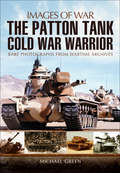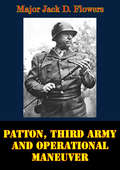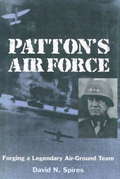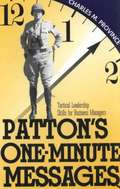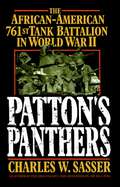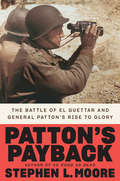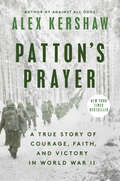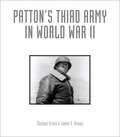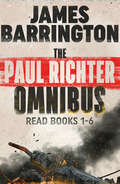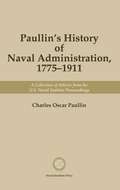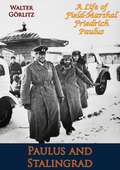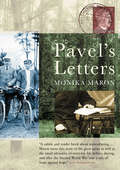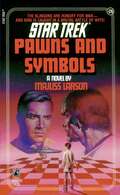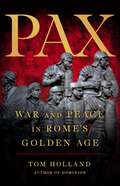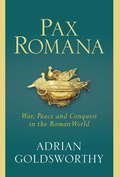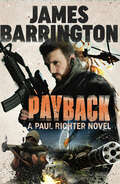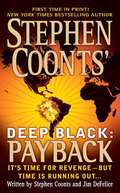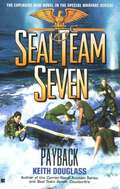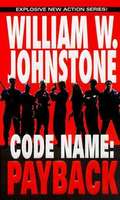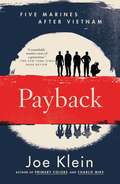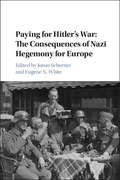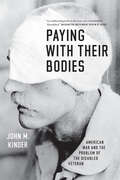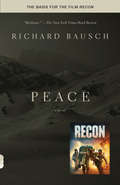- Table View
- List View
Patton Tanks: D-day To Victory (Images Of War Bks.)
by Michael GreenThe end of WW2 and the early Cold War years saw the need for a more powerful tank than the Sherman and Pershing tanks. The first Patton tanks (M46) were converted Pershings which saw service in Korea. As the Cold War intensified, the M47 with a more effective 90mm gun and turret went into mass production (9000 built) and countered the Soviet build up.The M48 entered service in 1953 and the M47s were sold off to allies whose armies were being rebuilt.The original M48 had serious deficiencies. Nevertheless over 12000 of numerous variants (MY8A1/A2/A2C) came into service. These were followed by the M48A3 which the Marines took to Vietnam.In the late 1950s the Americans overcame their aversion to diesel power and the M60 with its British designed 105mm gun came into service. By 1982 over 15000 units had been built in four basic models.Simultaneously 200 of the M48A5 with the 105mm gun went into service with the Army Reserve and National Guard and friendly foreign armies.To complicate matters, countries such as Israel made their own modifications to M48s which remained in service until the late 1990s.As this fascinating book reveals Pattons were made into specialist role vehicles, be they anti-aircraft, flame throwers, recovery, combat engineer.
Patton, Third Army And Operational Maneuver
by Major Jack D. FlowersOn 16 December 1944, the German Army launched an offensive in the Ardennes to split Allied forces and retake the ports of Antwerp and Liege. The German advance split the XII Army forces and left the 101st Airborne Division surrounded at Bastogne. To relieve the encircled units in the Ardennes and defeat the German offensive, Third Army conducted an impressive counterattack into the flank of the Germans. The flexibility to turn ninety degrees during the worst winter in thirty-eight years and relieve the encircled forces stands out as one of the greatest operational maneuvers in history. While this operation is unique, the actions of the commander and staff that planned and executed it deserve closer analysis to determine what enabled them to orchestrate this maneuver. It is especially remarkable, when taken in context, how rapidly the Army changed during the previous four years.The US Army anticipating eventual war in Europe began a transformation which included drastic changes in force structure and doctrine. The primary transformation in doctrine was the revision of Field Service Regulation 100-5. The 1941 edition of 100-5 superseded a tentative version published in 1939 which was the first major revision of warfighting doctrine since 1923. It was with this manual that the Army went to war. It was also the manual used to train and teach new and reserve officers who had little experience in the study and practice of war. How important and to what extent did Patton's Third Army apply the doctrine in conducting the Battle of the Bulge?Particularly relevant to serving officers today is to analyze the operations of Third Army in terms of doctrine that existed in 1944 and today's current doctrine. An examination of similarities and differences between the doctrines may allow development of possible conclusions on the ability of future forces to conduct decisive maneuver in compressed time and space.
Patton's Air Force
by David N. SpiresFrom the time the Third Army became operational on August 1, 1944, until the guns fell silent on May 8, 1945, Lt. Gen. George S. Patton's troops covered more ground and took more enemy prisoners than any other Allied army in northwest Europe. Brig. Gen. Otto P. Weyland's XIX Tactical Air Command (TAC) provided air support every step of the way. Their combined success is something of an anomaly; air-ground relationships are notoriously confrontational and plagued with inter-service competition. How did Patton and Weyland work together to achieve such astounding success? Drawing on exclusive access to official records, David N. Spires finds that this success was due to four key developments: the maturation of tactical aviation doctrine, effective organizational procedures, a technical revolution in equipment, and, above all, the presence of pragmatic men of goodwill who made the system work. He focuses on the highly effective personal relationship between Patton and Weyland -- men who respected, trusted, and fully relied on each other and their respective subordinates. This collaboration extended all the way down the chain of command: Patton's ground troops and Weyland's airmen trained together in England, and so by the time they entered combat, they operated together as a single unit. Contrary to conventional wisdom, air-ground relationships in the field can be cooperative rather than confrontational. Today's air and ground officers can continue to benefit from the amazing success of the Third Army and the XIX TAC.
Patton's One-Minute Messages: Tactical Leadership Skills of Business Managers
by Charles ProvinceThis collection of George S. Patton's pithy one-liners shows how business managers can succeed by applying the combat-tested principles of one of America's most famous battlefield leaders. Also featured are the works of W. Edwards Deming and Walter A. Shewhart, two pioneers in quality control who have influenced management practice for over 50 years.
Patton's Panthers: The African-American 761st Tank Battalion In World War II
by Charles W. SasserOn the battlefields of World War II, the men of the African American 761st Tank Battalion under General Patton broke through enemy lines with the same courage with which they broke down the racist limitations set upon them by others—proving themselves as tough, reliable, and determined to fight as any tank unit in combat.Beginning in November 1944, the 761st Tank Battalion engaged the enemy for 183 straight days, spearheading many of General Patton's offensives at the Battle of the Bulge and in six European countries. No other unit fought for so long and so hard without respite. The 761st defeated more than 6,000 enemy soldiers, captured thirty towns, liberated Jews from concentration camps—and made history as the first African American armored unit to enter the war. This is the true story of the Black Panthers, who proudly lived up to their motto (Come Out Fighting) and paved the way for African Americans in the U.S. military—while battling against the skepticism and racism of the very people they fought for.
Patton's Payback: The Battle of El Guettar and General Patton's Rise to Glory
by Stephen L. MooreA stirring World War II combat story of how the legendary George Patton reinvigorated a defeated and demoralized army corps, and how his men claimed victory over Germany&’s most-feared general, Erwin Rommel &“Moore brings you to the battlefield and into the mind of a fearless military genius.&”—Brian Kilmeade, bestselling author of The President and the Freedom Fighter • &“Essential reading.&”—Kevin Maurer, #1 NYT bestselling coauthor of No Easy Day • &“[Moore] has a smooth prose style and a firm grasp of detail.&”—The Wall Street JournalIn March 1943, in their first fight with the Germans, American soldiers in North Africa were pushed back fifty miles by Rommel&’s Afrika Korps and nearly annihilated. Only the German decision not to pursue them allowed the Americans to maintain a foothold in the area. General Eisenhower, the supreme commander, knew he needed a new leader on the ground, one who could raise the severely damaged morale of his troops. He handed the job to a new man: Lieutenant General George Patton. Charismatic, irreverent, impulsive, and inspiring, Patton possessed a massive ego and the ambition to match. But he could motivate men to fight. He had just ten days to whip his dispirited troops into shape, then throw them into battle against the Wehrmacht&’s terrifying Panzers, the speedy and powerful German tanks that U.S. forces had never defeated. Patton, who believed he had fought as a Roman legionnaire in a previous life, relished the challenge to turn the tide of America&’s fledgling war against Hitler—and the chance to earn a fourth star.
Patton's Prayer: A True Story of Courage, Faith, and Victory in World War II
by Alex KershawFrom Alex Kershaw, author of the New York Times bestseller Against All Odds, comes an epic story of courage, resilience, and faith during the Second World War General George Patton needed a miracle. In December 1944, the Allies found themselves stuck. Rain had plagued the troops daily since September, turning roads into rivers of muck, slowing trucks and tanks to a crawl. A thick ceiling of clouds had grounded American warplanes, allowing the Germans to reinforce. The sprint to Berlin had become a muddy, bloody stalemate, costing thousands of American lives. Patton seethed, desperate for some change, any change, in the weather. A devout Christian, he telephoned his head chaplain. &“Do you have a good prayer for the weather?&” he asked. The resulting prayer was soon printed and distributed to the 250,000 men under Patton&’s command. &“Pray when driving,&” the men were told. &“Pray when fighting. Pray alone. Pray with others. Pray by night and pray by day. Pray for the cessation of immoderate rains, for good weather for Battle. . . . Pray for victory. . . . Pray for Peace.&” Then came the Battle of the Bulge. Amid frigid temperatures and heavy snow, 200,000 German troops overwhelmed the meager American lines in Belgium&’s Ardennes Forest, massacring thousands of soldiers as the attack converged on a vital crossroads town called Bastogne. There, the 101st Airborne was dug in, but the enemy were lurking, hidden in the thick blanket of fog that seemed to never dissipate. A hundred miles of frozen roads to the south, Patton needed an answer to his prayer, fast, before it was too late.
Patton's Third Army in World War II
by Michael Green James BrownPatton was champing at the bit to lead the D-Day invasion, but Eisenhower placed him in command of a decoy unit, the First U.S. Army Group. Nearly seven weeks after D-Day, Patton finally got his chance to take Third Army into battle. He began a ten-month rampage across France, driving through Germany and into Nazi-occupied Czechoslovakia and Austria. Along the way Third Army forces entered the Battle of the Bulge, breaking the siege of Bastogne. It was a turning point in the war, and afterward the Third Army pushed eastward again. Patton’s Third Army in World War II covers Patton’s command of Third Army with a focus on the armor. It was a new style of fighting, avoiding entrenched infantry warfare by continuously pushing forward, and it appealed to Patton’s hard-charging personality. Archival photos along with frequent quotes complete the portrait of Patton as well as his men as they fight their way across the Third Reich.
The Paul Richter Omnibus (An Agent Paul Richter Thriller)
by James BarringtonThe bestselling military thrillers, now in a special omnibus editionPaul Richter: listed as working with the Foreign Operations Executive. Special forces and pilot experience. Trouble? Guaranteed. From supersonic chases above the Russian tundra to terrorists in Dubai and covert battles in North Korea, these are the most explosive thrillers you’ll ever read. This omnibus edition contains all six thrilling books in the series, perfect for fans of Robert Ludlum, Frederick Forsyth and Brad Thor.
Paullin's History of Naval Administration 1775-1911
by Charles Oscar PaullinThe classic collection of articles from the U.S. Naval Institute Proceedings, now in ebook form.
Paulus and Stalingrad: A Life of Field-Marshal Friedrich Paulus
by Ernst Alexander Paulus Col. R. H. Stevens Walter GörlitzA biography of the Field-Marshal who led the German Sixth Army during the Battle of Stalingrad. Görlitz used the Paulus' notes, correspondence and documents provided by the Paulus family after the Field Marshall died to provide a deep in-depth look at the life of Paulus. Paulus and the Sixth Army surrendered to the Russians, after some of the worst fighting on the entire Eastern Front in the freezing snow having been let down by Hitler. Paulus himself was not released from captivity until 1953, he died in 1957.
Pavel's Letters
by Monika MaronTeasing her family's past out of the fog of oblivion and lies, one of Germany's greatest writers asks about the secrets families keep, about the fortitude of ordinary people in extraordinary circumstances, and about what becomes of the individual mind when the powers that be turn against it.Born in a working-class suburb of wartime Berlin, Monika Maron grew up a daughter of the East German nomenklatura, despairing of the system her mother, Hella, helped create. Haunted by the ghosts of her Baptist grandparents, she questions her mother, whose selective memory throws up obstacles to Maron's understanding of her grandparents' horrifying denouement in Polish exile. Maron reconstructs their lives from fragments of memory and a forgotten box of letters. In telling her family's powerful and heroic story, she has written a memoir that has the force of a great novel and also stands both as an elaborate metaphor for the shame of the twentieth century and a life-affirming monument to her ancestors.
Pawns and Symbols (Star Trek: The Original Series #26)
by Majliss LarsonPawns And Symbols Threatened by a deadly famine, the Klingon Empire is on the verge of igniting a mad interplanetary war of conquest. When an earthquake destroys a remote Federation research station, Jean Czerny, agricultural scientist, succumbs to amnesia. Stranded on enemy borders, she is imprisoned by Kang, the evil commander of a Klingon battleship. Now Kirk must play a dangerous game of mind strategy to prevent a savage attack on the Federation!
Pax: War and Peace in Rome's Golden Age
by Tom HollandFrom a &“remarkably gifted historian&” (New York Times), the definitive account of the golden age of Rome -- an ultimate superpower at the pinnacle of its greatness The Pax Romana has long been shorthand for the empire&’s golden age. Stretching from Caledonia to Arabia, Rome ruled over a quarter of the world&’s population. It was the wealthiest and most formidable state in the history of humankind. Pax is a captivating narrative history of Rome at the height of its power. From the gilded capital to realms beyond the frontier, historian Tom Holland shows ancient Rome in all its glory: Nero&’s downfall, the destruction of Jerusalem and Pompeii, the building of the Colosseum and Hadrian&’s Wall, the conquests of Trajan. Vividly sketching the lives of Romans both ordinary and spectacular, from slaves to emperors, Holland shows that Roman peace was the fruit of unprecedented military violence. A stunning portrait of Rome&’s glory days, this is the epic history of the Pax Romana.
Pax Romana: War, Peace and Conquest in the Roman World
by Adrian GoldsworthyThe Pax Romana is famous for having provided a remarkable period of peace and stability, rarely seen before or since. Yet the Romans were first and foremost conquerors, imperialists who took by force a vast empire stretching from the Euphrates in the east to the Atlantic coast in the west. Their peace meant Roman victory and was brought about by strength and dominance rather than co-existence with neighbours. The Romans were aggressive and ruthless, and during the creation of their empire millions died or were enslaved.But the Pax Romana was real, not merely the boast of emperors, and some of the regions in the Empire have never again lived for so many generations free from major wars. So what exactly was the Pax Romana and what did it mean for the people who found themselves brought under Roman rule?Acclaimed historian Adrian Goldsworthy tells the story of the creation of the Empire, revealing how and why the Romans came to control so much of the world and asking whether the favourable image of the Roman peace is a true one. He chronicles the many rebellions by the conquered, and describes why these broke out and why most failed. At the same time, he explains that hostility was only one reaction to the arrival of Rome, and from the start there was alliance, collaboration and even enthusiasm for joining the invaders, all of which increased as resistance movements faded away.A ground-breaking and comprehensive history of the Roman Peace, Pax Romana takes the reader on a journey from the bloody conquests of an aggressive Republic through the age of Caesar and Augustus to the golden age of peace and prosperity under diligent emperors like Marcus Aurelius, offering a balanced and nuanced reappraisal of life in the Roman Empire.
Pax Romana: War, Peace and Conquest in the Roman World
by Adrian Goldsworthy Dr Adrian Goldsworthy LtdThe Pax Romana is famous for having provided a remarkable period of peace and stability, rarely seen before or since. Yet the Romans were first and foremost conquerors, imperialists who took by force a vast empire stretching from the Euphrates in the east to the Atlantic coast in the west. Their peace meant Roman victory and was brought about by strength and dominance rather than co-existence with neighbours. The Romans were aggressive and ruthless, and during the creation of their empire millions died or were enslaved.But the Pax Romana was real, not merely the boast of emperors, and some of the regions in the Empire have never again lived for so many generations free from major wars. So what exactly was the Pax Romana and what did it mean for the people who found themselves brought under Roman rule?Acclaimed historian Adrian Goldsworthy tells the story of the creation of the Empire, revealing how and why the Romans came to control so much of the world and asking whether the favourable image of the Roman peace is a true one. He chronicles the many rebellions by the conquered, and describes why these broke out and why most failed. At the same time, he explains that hostility was only one reaction to the arrival of Rome, and from the start there was alliance, collaboration and even enthusiasm for joining the invaders, all of which increased as resistance movements faded away.A ground-breaking and comprehensive history of the Roman Peace, Pax Romana takes the reader on a journey from the bloody conquests of an aggressive Republic through the age of Caesar and Augustus to the golden age of peace and prosperity under diligent emperors like Marcus Aurelius, offering a balanced and nuanced reappraisal of life in the Roman Empire.
Payback (An Agent Paul Richter Thriller)
by James BarringtonA race against time in the Middle East.Hauled back from an exercise with the SAS, Paul Richter is tasked with a short-notice extraction. It goes well and as a reward he’s given an easy job: investigating James Holden, a middle-aged Englishman living in Dubai, who appears to predict terrorist attacks.It should be simple, but almost as soon as he arrives in Dubai, Richter is diverted to Bahrain. Then it all begins to get complicated. Who is the secretive patient in the nearby Manama hospital? And why has a US State Department jet carrying a specialist CIA team been diverted to Cairo?Nothing makes sense until Richter finally uncovers the outline of a truly catastrophic plot...An utterly exhilarating and no-holds-barred thriller, perfect for fans of Kyle Mills, Brad Thor and Frederick Forsyth.
Payback (Deep Black #4)
by Jim Defelice Stephen CoontsRECRUITED:A crack team of cover agents.Word is out to ex-Marine sniper Charlie Dean and his team of the National Security Agency: Infiltrate the highest stratum of Peruvian political power and derail a renegade general from acing an election. All Dean has to do is find a way inside an impenetrable bank vault protected by armed guards round the clock-it's all in a day's work for the men and women of Deep Black.
Payback (Seal Team Seven, #17)
by Keith DouglassDefeated by South Korean and U.S. forces, North Korea secures an oil rig off the coast of California for a retaliation effort. Now, it's up to the Navy SEALs to force them to surrender--or sink.
Payback (Code Name Series #1)
by William W. JohnstoneAn explosive new action series! Ex-CIA agent John Barrone spearheads a secret strike force of elite law enforcement and intelligence professionals on a seek-and-destroy mission against America's enemies. As terrorists smuggle a bio-weapon of mass destruction into the West Coast, Barrone and his team race against time to take on the plotters.
Payback: Five Marines After Vietnam
by Joe KleinFrom the author of Primary Colors, "a remarkably sensitive story of a generation" (The New York Times Book Review): The critically acclaimed true story of five Marines who fought together in a bloody battle during the Vietnam War, barely escaping with their lives, and of what happened when they came home.In 1981, while the country was celebrating the end of the Iran hostage crisis, an unemployed Vietnam veteran named Gary Cooper went berserk with a gun, angry over the jubilant welcome the hostages received in contrast to his own homecoming from Vietnam, and was killed in a fight with police. In what has been called "the most eloquent work of nonfiction to emerge from Vietnam since Michael Herr's Dispatches" (The New York Times), Joe Klein tells Cooper's story, as well as the stories of four of the other vets in Cooper's platoon. The story begins with an ambush and a grisly battle in the Que Son Valley in 1967, but Payback is less about remembering the war and more about examining its long-term effects on the grunts who fought it. Klein fills in the next fifteen years of these Marines' lives after they return home, with "the sort of fine and private detail one ordinarily finds only in fiction" (People). The experiences of these five men capture the struggles of a whole generation of Vietnam veterans and their families. Klein's "near-hypnotic" account (Daily News, New York) is, to this day, both a remarkable piece of reporting and "some of the most vivid, harrowing, and emotionally honest writing to come out of Vietnam" (The Washington Post Book World).
Paying for Hitler's War
by Jonas Scherner Eugene N. WhiteDuring World War II, Germany occupied much of continental Europe. Although the social and political history of this occupation has been studied extensively, the economics of the unprecedented transfer of resources has received surprisingly little attention. Allies, neutrals, and conquered nations under German hegemony were a vital source of supplies for Hitler's war machine. Without the war material, consumer goods and labor they provided, Germany would not have been able to wage a prolonged multi-front war. All of these countries suffered enormous losses, but each had a distinct experience that depended on Germany's wartime needs, whether they were allied, occupied or neutral, and their place in Nazi racial ideology. Paying for Hitler's War is a comparative economic study which explores these different experiences through case studies of twelve nations spanning the European continent.
Paying with Their Bodies: American War and the Problem of the Disabled Veteran
by John M. KinderChristian Bagge, an Iraq War veteran, lost both his legs in a roadside bomb attack on his Humvee in 2006. Months after the accident, outfitted with sleek new prosthetic legs, he jogged alongside President Bush for a photo op at the White House. The photograph served many functions, one of them being to revive faith in an American martial ideal--that war could be fought without permanent casualties, and that innovative technology could easily repair war's damage. When Bagge was awarded his Purple Heart, however, military officials asked him to wear pants to the ceremony, saying that photos of the event should be "soft on the eyes. " Defiant, Bagge wore shorts. America has grappled with the questions posed by injured veterans since its founding, and with particular force since the early twentieth century: What are the nation's obligations to those who fight in its name? And when does war's legacy of disability outweigh the nation's interests at home and abroad? In Paying with Their Bodies, John M. Kinder traces the complicated, intertwined histories of war and disability in modern America. Focusing in particular on the decades surrounding World War I, he argues that disabled veterans have long been at the center of two competing visions of American war: one that highlights the relative safety of US military intervention overseas; the other indelibly associating American war with injury, mutilation, and suffering. Kinder brings disabled veterans to the center of the American war story and shows that when we do so, the history of American war over the last century begins to look very different. War can no longer be seen as a discrete experience, easily left behind; rather, its human legacies are felt for decades. The first book to examine the history of American warfare through the lens of its troubled legacy of injury and disability, Paying with Their Bodies will force us to think anew about war and its painful costs.
Pe-2 Guards Units of World War 2
by Andrey Yurgenson Dmitriy KhazanovPetlyakov's Pe-2 was the most numerous Soviet twin-engined bomber of World War 2, the aircraft being used as a dive-bomber, ground attack platform and dedicated reconnaissance type. The first examples entered service in August 1940, and by the time production came to end in late 1945, no fewer than 10,547 examples had been built. These equipped more than 80 bomber air regiments, and of the latter, two were accorded Guards Air Corps status, as were six air regiments. Amongst the former was the 2nd Guards Bomber Air Corps, which was commanded by the legendary General Polbin, who was twice made a Hero of the Soviet Union. Pe-2 bomber and reconnaissance versions (the latter in service with four Guards reconnaissance air regiments of the Air Force and one regiment of Naval Aviation) were extensively used from the frozen Arctic north to the balmy Crimea front. A number of Pe-2 also saw brief combat against Japan in the final weeks of World War 2.
Peace
by Richard BauschItaly, near Cassino. The terrible winter of 1944. Dismal icy rain falls, unabated, for days. Three American soldiers set out on the grueling ascent of a perilous Italian mountainside in the murky closing days of the Second World War. Haunted by their sergeant's cold-blooded murder of a young girl, and with only an old man of uncertain loyalties as their guide, they trudge on in a state of barely suppressed terror and confusion. With snipers lying in wait for them, the men are confronted by agonizing moral choices . . . Taut and propulsive - Peace is a feat of economy, compression, and imagination, a tough and unmistakably contemporary meditation on the corrosiveness of violence, the human cost of war, and the redemptive power of mercy.
